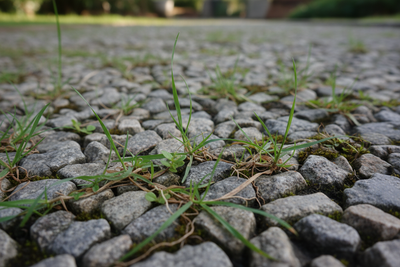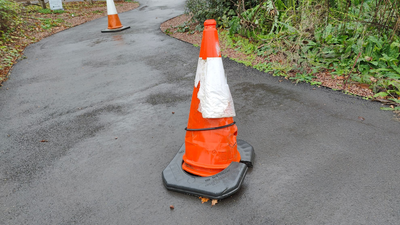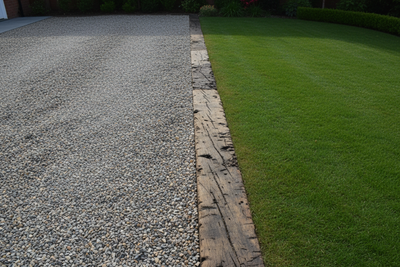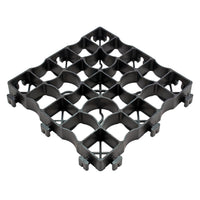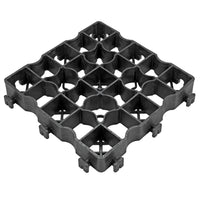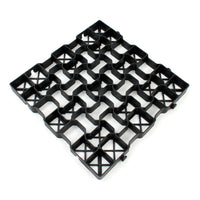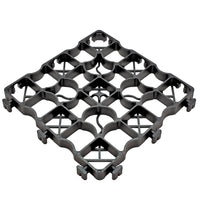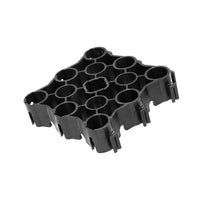Things To Consider When Building a Gravel Driveway On a Slope
Gravel driveways offer many benefits over alternative materials, from their ability to freely drain and clear surface water quickly, through to the added security of the crunch of gravel underfoot acting as an early warning system.
Unfortunately, not all of us live on a level piece of ground, and often natural undulations in the ground surrounding properties can cause issues for gravel driveways if the right precautions are not taken.
For us to address how to build a gravel driveway on a slope, we first need to address the common issues that sloped gravel driveways face.
What are the common issues for sloped gravel driveways?
Slumping
The most prevalent issue for gravel-only driveways is the slumping of gravel to the lowest point. In short, whenever you lay a gravel driveway without using a gravel grid system, you will be fighting gravity constantly.
With every vehicle movement, downfall of rain, or even strong breeze, your gravel will naturally gravitate to the lowest point, which may leave you with bare patches or with areas with excessive depth.
Gravel Retention
If your driveway slopes down to a road, you may find that you have issues with the gravel gradually disappearing into the road, often resulting once again in bare patches on the driveway. Depending on the severity of the slope of the driveway, this process could take weeks or months, but it will occur eventually.
Rutting
This issue can occur on flat gravel driveways too, but is more common on slopes as it happens when the gravel builds up deeply due to shifting from higher ground. Rutting happens when a vehicle's wheels pass over the same point constantly, leaving low patches where the wheels constantly track and high patches elsewhere. This makes the drive hard to steer and manoeuvre vehicles on.
Traction
Gravel alone does not provide much traction; if anything, it acts almost as a lubricant between the sub-ground and the vehicle's wheels. This can cause vehicles to lose traction, especially when the weather is wet or frosty.
What solutions for sloped gravel driveways are available?
So, can you gravel a sloped driveway? The answer is yes, and there are a couple of ways to tackle this. Both have advantages and disadvantages.
Gravel Selection
For mild slopes, there is the possibility of simply tweaking the variety of gravel you are going to use. By selecting a more angular gravel, you can minimise the amount of maintenance work that needs to be done. Rounder gravel will tend to roll more, as more acutely
angled gravel binds and interlocks. This is not a silver bullet, though; you will still need to manage the gravel from time to time, redistributing it if it does slump or rut.
Pros:
-
Cheap - Often, an acutely angled gravel costs a similar amount to any other gravel.
Cons:
- Heavier in maintenance than other options. As gravel will still need frequent redistribution, as it will eventually move down the slope.
- Rutting can still occur.
- Slumping can still occur.
- Gravel retention can still be an issue.
- It won't work on very steep slopes.
Gravel Grids -
Gravel pavers are a modern solution for gravel driveways that address many of the main issues gravel driveways face, without detracting from the main benefits of gravel driveways. These interlocking pavers do the following;
- Distribute the load of vehicles passing over them
- Lock gravel into individual cells within each tile
- Allow water to flow through the grid freely
As the grids contain the gravel into individual cells, the amount of overall movement of aggregate within the gravel driveway is vastly reduced, if not almost completely stopped. The grids themselves can be pinned in place on extreme slopes, giving even greater stability. Most gravel grid systems also feature grip nodules on top of the grids, enhancing traction for vehicles passing over them.
Pros:
- Prevents gravel movement. - Each cell contains the gravel, minimising how far within the area it can move.
- Stops gravel rutting. - As the grid spreads the load of any vehicles over a larger area, it prevents the frequently run-over areas from sinking, causing ruts.
- Prevents potholes. - Similarly to above, the grids help prevent vehicles from digging in, causing uncomfortable potholes.
- Significantly increases gravel retention - Cellular structure helps gravel stay within the driveway area.
- Prevents gravel slumping - gravel will no longer be able to freely migrate down the slope causing a glut as it is locked within each cell.
- Less maintenance. - As all your aggregates stay put in each cell and there are frequent physical barriers within the driveway in the form of cell walls it is also harder for weeds to get established or spread, making it easier to keep ontop of any issues.
- Improves traction. - The top of the grids acts like a traction pattern, giving both foot traffic and vehicle traffic more grip. Some grids even have nodules ontop of their raised upper edges to enhance traction.
Cons:
- Cost - although still relatively cheap, the grids do, of course, cost money, adding to the overall budget of a project.
- Longer Installation Process - While a gravel driveway can be laid down quickly, laying grids first requires a bit more effort to ensure they are flat and have a solid foundation.
Conclusion
If you are looking to install a gravel driveway or parking area on a slope, consider using a gravel grid/paver system such as the EcoGrid e40 or GeoGrid Premium. By doing so, you will not only improve the traction and usability of the area. Still, you will also save on maintenance costs (and potentially also save on subsequent purchases of gravel often required to “top up” traditional installations that do not use grids.
If you need to speak to one of our technical experts, we will be happy to help you get the right gravel grid system for your project, ensuring you get great value for money and great results. You can call us on 01905 794 875 or use our contact form to get in touch.
- Author

